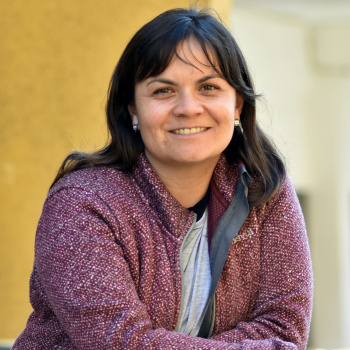Young Investigator at Centro Interdisciplinario de Neurociencia de Valparaíso.
Assistant Professor at Facultad de Odontología, Universidad de Valparaíso.
Graduate in Biochemist, Pontificia Universidad Católica de Valparaíso.
PhD. in Science mention Neuroscience, Universidad de Valparaíso.
Contact information:
E-mail: angelina.palacios@uv.cl
Pasaje Harrington 287 Playa Ancha. Valparaíso, Chile.
Phone: (56)-(32)-2508555
Autism Spectrum Disorder (ASD) is a complex syndrome, characterized by poor social interaction, poor language, and stereotyped and repetitive behavior. In addition, a high number of individuals with ASD exhibit altered sleep regulation, increased anxiety behavior and impaired cognitive functions such as learning and memory. The study of ASD has been focused in children and young people and despite the huge number of people with ASD are adult and elderly, little is known about the impact of the aging on this age group. Considering that life expectancy is increased in normal population and that some cognitive dysfunctions are associated to aging, it is important to known if the hallmark features of ASD are ameliorated or impaired with aging. Studies relating ASD and aging are scarce and controversial.
Drosophila is an excellent model for genetic studies and has been widely used as a model organism to study aging, social interaction, sleep behavior, and cognitive functions like learning and memory. The mushroom bodies and the adult neuromuscular junction in Drosophila have been useful as neuronal substrates to evaluate age-related connectivity changes and synaptic remodeling in model of human neurodevelopmental disorders. My current research is focused in to understand the impact of the aging in ASD, using old Drosophila models of ASD that exhibit defects in regulation of synaptogenesis, dysfunction in the dopaminergic system and defects in sensory process. These genes have been linked to ASD, however how these genes/proteins are involved in aging process in ASD and how these are linked to the pathogenic mechanism remains elusive.
- Palacios-Muñoz A, de Paula Moreira D, Silva V, García IE, Aboitiz F, Zarrei M, Campos G, Rennie O, Howe JL, Anagnostou E, Ambrozewic P, Scherer SW, Passos-Bueno MR, Ewer J. (2022). Mutations in trpγ, the homologue of TRPC6 autism candidate gene, causes autism-like behavioral deficits in Drosophila. Mol Psychiatry. 2022 May 2. doi: 10.1038/s41380-022-01555-1. Online ahead of print. PMID: 35501408
- Silva V, Palacios-Muñoz A, Volonté M, Frenkel L, Ewer J, Ons S. (2021). Orcokinin neuropeptides regulate reproduction in the fruit fly, Drosophila melanogaster. Insect Biochem Mol Biol. 2021 Dec;139:103676. doi: 10.1016/j.ibmb.2021.103676. Epub 2021 Nov 3. PMID: 34742859
- Valeria Silva, Angelina Palacios-Muñoz, Zeynep Okray, Karen L. Adair, Scott Waddell, Angela E. Douglas and John Ewer. (2020). The impact of the gut microbiome on memory and sleep in Drosophila. Journal of Experimental Biology. 2020 Dec 29:jeb.233619. doi: 10.1242/jeb.233619.
- Angelina Palacios-Muñoz and John Ewer. (2018). Calcium and cAMP directly modulate the speed of the Drosophila circadian clock. PLoS Genetics. Jun 7;14(6):e1007433. doi: 10.1371/journal.pgen.1007433.
- Mareike Selcho*, Carola Millán*, Angelina Palacios-Muñoz*, Lilian Ubillo, Jiangtian Chen, Franziska Ruf Chihiro Ito, Christian Wegener, and John Ewer. (2017). Central and peripheral clocks are coupled by a neuropeptide pathway in Drosophila. Nature Communications. May 30;8:15563. doi:10.1038/ncomms15563. [*]Equal contribution.
- García IE., Maripillán J., Jara O., Ceriani R., Palacios-Muñoz A., Ramachandran J., et al. (2015) Keratitis-Ichthyosis-Deafness syndrome-associated Cx26 mutants produce nonfunctional gap junctions but hyperactive hemichannels when co-expressed with wild type Cx43. J Invest Dermatol. 2015 May;135(5):1338-47. doi: 10.1038/jid.2015.20. Epub 2015 Jan 27
- Palacios-Munoz A., Escobar MJ., Vielma A, Araya J, Martínez AD, Astudillo A, Valdivia G, García IE., Schmachtenberg O., Hurtado J., Palacios AG (2014) Role of Connexin Channels in Retinal Light Response in a Diurnal Rodent. Front Cell Neurosci. 2014 Aug 25;8:249. doi: 10.3389/fncel.2014.00249. eCollection 2014.



